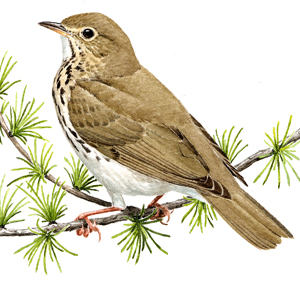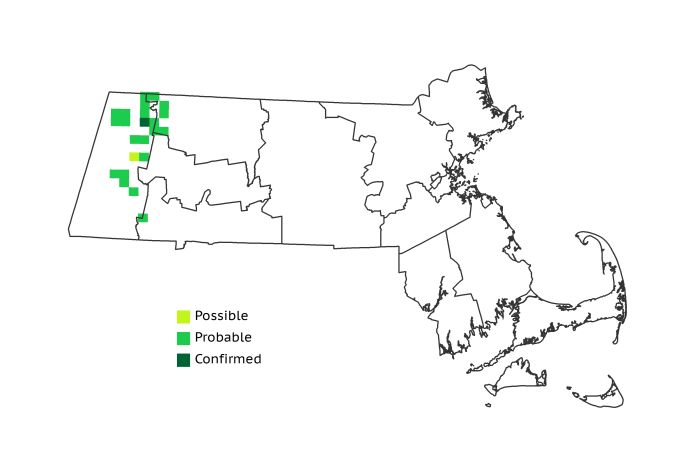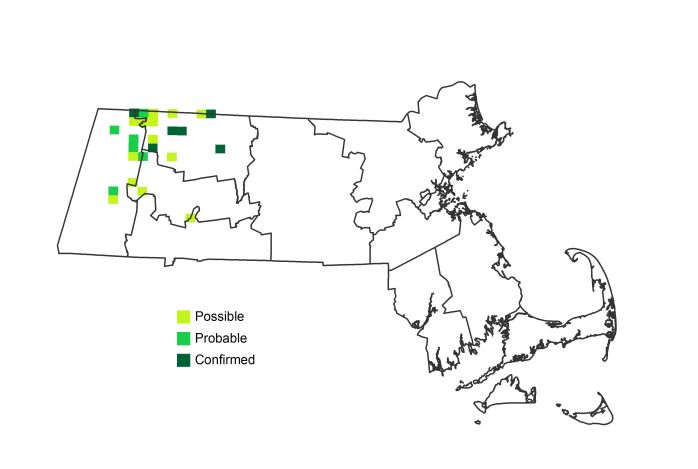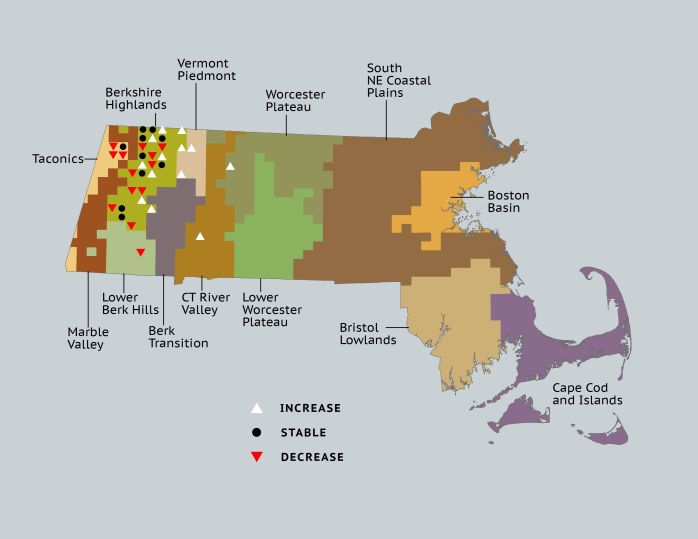Find a Bird
Swainson's Thrush
Catharus ustulatus

Local and stable
“Years ago in the great woods of eastern Maine, I saw an irruption of bud-moths among the spruce trees and there from every direction came the song of the Olive-backed Thrush.” – Edward Howe Forbush, Birds of Massachusetts and Other New England States
The Swainson’s Thrush is a bird of conifer forests whose range falls mainly north of Massachusetts. In fact, Swainson’s Thrushes can be found from Nova Scotia to Alaska wherever suitable forest conditions exist. Particularly on the west coast, Swainson’s Thrushes can inhabit mountainous coastal forests or be found near sea level, but in Massachusetts the species displays a marked preference for high-elevation haunts.
Historic Status
The Olive-backed Thrush, as it was once known, was observed primarily as a migrant by Massachusetts’ bird observers during the 1800s. Late in that century, supposition arose that the species was breeding in the western portions of the state. As it turned out, those suppositions were correct, and eventually nesting verification was obtained primarily in Berkshire County, but also in the higher elevations of Franklin and Worcester Counties (Bagg & Eliot 1937). The cutting of the spruce forests in the early part of the twentieth century, however, gradually led to a population decline in Massachusetts (Griscom & Snyder 1955).
Atlas 1 Distribution
Swainson’s Thrushes were thinly distributed by the time of Atlas 1, as were the high-elevation conifer forests that they required for nesting. In all other situations, they were totally absent. The Taconic Mountains and Berkshire Highlands accounted for almost all Swainson’s Thrush breeding activity, and the birds completely skipped over the lower, more mixed woodlands characteristic of the Marble Valleys region. The species’ ethereal upward-spiraling song was heard in one Lower Berkshire Hills block, but its strong preference for high-altitude climates apparently made the rest of the state unsuitable for breeding.
Atlas 2 Distribution and Change
The Swainson’s Thrush is a classic habitat specialist, occupying a very narrow range in Massachusetts. It occupied the same percentage of blocks in Atlas 2 as it did in Atlas 1, and its stronghold was still in the Taconics and Berkshire Highlands. The Vermont Piedmont enjoyed modest occupancy, and using the effort-controlled data the Worcester Plateau gained 1 block, as did the Connecticut River Valley, increasing both regions by one sighting from none in Atlas 1.
Atlas 1 Map

Atlas 2 Map

Atlas Change Map

Ecoregion Data
Atlas 1 | Atlas 2 | Change | ||||||
Ecoregion | # Blocks | % Blocks | % of Range | # Blocks | % Blocks | % of Range | Change in # Blocks | Change in % Blocks |
Taconic Mountains | 4 | 25.0 | 17.4 | 1 | 4.0 | 4.0 | -3 | -20.0 |
Marble Valleys/Housatonic Valley | 0 | 0.0 | 0.0 | 0 | 0.0 | 0.0 | 0 | 0.0 |
Berkshire Highlands | 18 | 32.7 | 78.3 | 18 | 32.7 | 72.0 | 0 | 0.0 |
Lower Berkshire Hills | 1 | 3.6 | 4.3 | 0 | 0.0 | 0.0 | -1 | -3.7 |
Vermont Piedmont | 0 | 0.0 | 0.0 | 2 | 11.8 | 8.0 | 2 | 16.7 |
Berkshire Transition | 0 | 0.0 | 0.0 | 0 | 0.0 | 0.0 | 0 | 0.0 |
Connecticut River Valley | 0 | 0.0 | 0.0 | 1 | 1.5 | 4.0 | 1 | 2.1 |
Worcester Plateau | 0 | 0.0 | 0.0 | 3 | 3.4 | 12.0 | 1 | 2.1 |
Lower Worcester Plateau | 0 | 0.0 | 0.0 | 0 | 0.0 | 0.0 | 0 | 0.0 |
S. New England Coastal Plains and Hills | 0 | 0.0 | 0.0 | 0 | 0.0 | 0.0 | 0 | 0.0 |
Boston Basin | 0 | 0.0 | 0.0 | 0 | 0.0 | 0.0 | 0 | 0.0 |
Bristol and Narragansett Lowlands | 0 | 0.0 | 0.0 | 0 | 0.0 | 0.0 | 0 | 0.0 |
Cape Cod and Islands | 0 | 0.0 | 0.0 | 0 | 0.0 | 0.0 | 0 | 0.0 |
Statewide Total | 23 | 2.4 | 100.0 | 25 | 2.4 | 100.0 | 0 | 0.0 |
Notes
Monitoring the range and abundance of Swainson’s Thrushes in Massachusetts would be an informing exercise. They exhibit several life history characters that are traits of other declining species in the Commonwealth: (1) they are at the southern edge of their breeding range in Massachusetts, (2) they are habitat specialists, and (3) they are long-distance migrants. The warming temperatures associated with climate change are eventually likely to make cool, high-elevation forests increasingly difficult to find in the Bay State. The Swainson’s Thrush shows a significant declining Breeding Bird Survey trend in the Eastern US overall.



